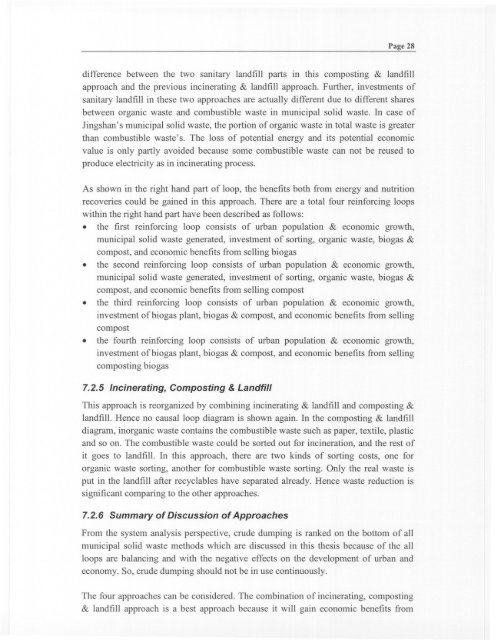a case study of municipal solid waste management in the ... - lumes
a case study of municipal solid waste management in the ... - lumes
a case study of municipal solid waste management in the ... - lumes
You also want an ePaper? Increase the reach of your titles
YUMPU automatically turns print PDFs into web optimized ePapers that Google loves.
Page 28difference between <strong>the</strong> two sanitary landfill parts <strong>in</strong> this compost<strong>in</strong>g & landfillapproach and <strong>the</strong> previous <strong>in</strong>c<strong>in</strong>erat<strong>in</strong>g & landfill approach. Fur<strong>the</strong>r, <strong>in</strong>vestments <strong>of</strong>sanitary landfill <strong>in</strong> <strong>the</strong>se two approaches are actually different due to different sharesbetween organic <strong>waste</strong> and combustible <strong>waste</strong> <strong>in</strong> <strong>municipal</strong> <strong>solid</strong> <strong>waste</strong>. In cage <strong>of</strong>J<strong>in</strong>gshan's <strong>municipal</strong> <strong>solid</strong> <strong>waste</strong>, <strong>the</strong> portion <strong>of</strong> organic <strong>waste</strong> <strong>in</strong> total <strong>waste</strong> is greaterthan combustible <strong>waste</strong>'s. The loss <strong>of</strong> potential energy and its potential economicvalue is only partly avoided because some combustible <strong>waste</strong> can not be reused toproduce electricity as <strong>in</strong> <strong>in</strong>c<strong>in</strong>erat<strong>in</strong>g process.As shown <strong>in</strong> <strong>the</strong> right hand part <strong>of</strong> loop, <strong>the</strong> benefits both ITom energy and nutritionrecoveries could be ga<strong>in</strong>ed <strong>in</strong> this approach. There are a total four re<strong>in</strong>forc<strong>in</strong>g loopswith<strong>in</strong> <strong>the</strong> right hand part have been described as folIows:. <strong>the</strong> first re<strong>in</strong>forc<strong>in</strong>g loop consists <strong>of</strong> urban population & economic growth,<strong>municipal</strong> <strong>solid</strong> <strong>waste</strong> generat ed, <strong>in</strong>vestment <strong>of</strong> sort<strong>in</strong>g, organic <strong>waste</strong>, biogas &compost, and economic benefits ITom sell<strong>in</strong>g biogas. <strong>the</strong> second re<strong>in</strong>forc<strong>in</strong>g loop consists <strong>of</strong> urban population & economic growth,<strong>municipal</strong> <strong>solid</strong> <strong>waste</strong> generated, <strong>in</strong>vestment <strong>of</strong> sort<strong>in</strong>g, organic <strong>waste</strong>, biogas &compost, and economic benefits ITom sell<strong>in</strong>g compost. <strong>the</strong> third re<strong>in</strong>forc<strong>in</strong>g loop consists <strong>of</strong> urban population & economic growth,<strong>in</strong>vestment <strong>of</strong> biogas plant, biogas & compost, and economic benefits ITom sell<strong>in</strong>gcompost. <strong>the</strong> fourth re<strong>in</strong>forc<strong>in</strong>g loop consists <strong>of</strong> urban population & economic growth,<strong>in</strong>vestment <strong>of</strong> biogas plant, biogas & compost, and economic benefits ITom sell<strong>in</strong>gcompost<strong>in</strong>g biogas7.2.5 Inc<strong>in</strong>erat<strong>in</strong>g, Compos t<strong>in</strong>g & LandfiIIThis approach is reorganized by comb<strong>in</strong><strong>in</strong>g <strong>in</strong>c<strong>in</strong>erat<strong>in</strong>g & landfill and compost<strong>in</strong>g &landfill. Hence no causal loop diagram is shown aga<strong>in</strong>. In <strong>the</strong> compost<strong>in</strong>g & landfilldiagram, <strong>in</strong>organic <strong>waste</strong> conta<strong>in</strong>s <strong>the</strong> combustible <strong>waste</strong> such as paper, textile, plasticand so on. The combustible <strong>waste</strong> could be sorted out for <strong>in</strong>c<strong>in</strong>eration, and <strong>the</strong> rest <strong>of</strong>it goes to landfill. In this approach, <strong>the</strong>re are two k<strong>in</strong>ds <strong>of</strong> sort<strong>in</strong>g costs, Olle fororganic <strong>waste</strong> sort<strong>in</strong>g, ano<strong>the</strong>r for combustible <strong>waste</strong> sort<strong>in</strong>g. Only <strong>the</strong> real <strong>waste</strong> isrut <strong>in</strong> <strong>the</strong> landfill after recyclables have separated aiready. Hence <strong>waste</strong> reduction issignificant compar<strong>in</strong>g to <strong>the</strong> o<strong>the</strong>r approaches.7.2.6 Summary <strong>of</strong> Discussion <strong>of</strong> ApproachesFrom <strong>the</strong> system analysis perspective, crude dump<strong>in</strong>g is ranked on <strong>the</strong> bortom <strong>of</strong> all<strong>municipal</strong> <strong>solid</strong> <strong>waste</strong> methods which are discussed <strong>in</strong> this <strong>the</strong>sis because <strong>of</strong> <strong>the</strong> allloops are balanc<strong>in</strong>g and with <strong>the</strong> negative effects on <strong>the</strong> development <strong>of</strong> urban andeconomy. So, crude dump<strong>in</strong>g should not be <strong>in</strong> lise cont<strong>in</strong>uously.The four approaches can be considered. The comb<strong>in</strong>ation <strong>of</strong> <strong>in</strong>c<strong>in</strong>erat<strong>in</strong>g, compost<strong>in</strong>g& landfill approach is a best approach because it will ga<strong>in</strong> economic benefitsITom
















